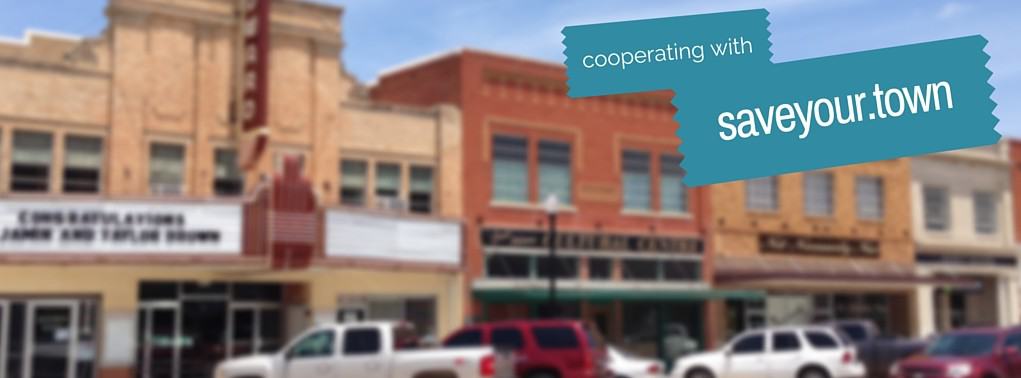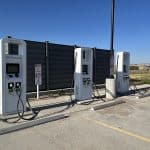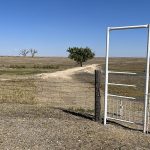
Autonomous shuttle testing in Las Vegas 2017. Photo by Becky McCray
News flash: Rural areas already have autonomous vehicles
Surprised? Both farming and mining already use fully or partially autonomous technology. I bet you already know about GPS-guided tractors, and you might know that big mines have big self-driving trucks and equipment. Almost no one mentions these highly-rural industries when talking about autonomous vehicles (AVs) for consumers.
Automated trucks are already handling freight primarily along rural stretches of highways. Two of the first are hauling beer and refrigerators.
Check out the map of AV stories from Governing.com. Notice how many are not in Silicon Valley, but instead out in rural areas. Be sure to click through the several years of archives on that map.
Despite these early rural uses, most of the fervent discussion of the potential uses for self-driving cars for people seem to focus on urban needs. Let’s turn that around and imagine what’s possible for rural communities when we leave the driving to the vehicle.
Would rural people accept driverless cars?
I keep seeing headlines about how older people are unlikely to accept self-driving cars, and rural people are stereotyped as closed to new ideas. Those are both negative factors, but there are lots of positives.
Society as a whole has accepted cars:
- shifting gears on their own
- holding a constant speed
- pumping the brakes in an emergency stop
- maintaining a safe following distance
- navigating
- turning on and off the headlights when needed
- dimming the headlights with oncoming traffic
- adjusting the windshield wipers as needed
- even parking themselves
Plus we have farmers and miners used to auto-steer tractors and trucks. Once small town seniors can no longer drive themselves, they often rely on local call-to-ride van services. Even small towns may have a taxi or two catering to the senior and lower income markets. I think small town people may be more accepting of self-driving cars than you might guess, especially when they help seniors maintain independence.
How small towns are different for AVs
There are also some transportation factors that are different in small towns. With our compact town layouts, small towns have shorter distances between local destinations. That can make in-town needs easier to serve with autonomous vehicles.
The longer distances between towns can really rack up the miles, and our long-haul trips lead to more accidents due to driver fatigue than our urban counterparts. It’s a compelling reason to delegate the driving to the vehicle.
Our slower broadband and spotty cell service can be a barrier. Besides GPS, AVs rely on continuous communication with other vehicles, sensors on objects around the streets and remote data through mesh networks. Small town broadband is going to need a major upgrade. Maybe AVs will provide the corporate motivations to finally make a difference here.
A few other factors to consider. Congestion and parking usually aren’t big problems. Our population skews older, and scheduled public transportation may be non-existent. We don’t have Uber or Lyft most places.
What could self-driving vehicles do in small towns?
Let’s brainstorm some potential use cases for autonomous vehicles in small towns. I’ll start, then you add your ideas. Don’t feel like you have to limit yourself to the practical, feasible or profitable. Let’s stretch our imaginations!
- Take seniors to doctors appointments, grocery shopping, to the senior center and more
- Run fixed mini-bus routes between a group of neighboring towns and small cities
- Shuttle to the nearest commercial airport (this is a good use for automated drone taxis)
- Commute to and from residential neighborhoods and large employers
- Deliver meals, groceries, library books, prescriptions, medicines, anything. What if every business and organization in town could deliver using a little fleet of shared delivery mini-cars?
- Parade vehicles (think how much fun this one could be)
- Connect the senior living or assisted living places with downtown
- Shuttle pedestrians across highways and other obstacles to walking
- Ride through holiday light displays
- Shuttle access to recreation areas like hiking and fishing without clogging the scenic areas with private vehicles in parking lots
- Shuttle to special events from remote parking
- Park and ride transit for visitors in tourist towns
- Circulate around the town square, Main Street or business district
- Turn the downtown into a car-free zone limited to self-driving shuttles, freeing up space for pedestrians, bicycle lanes, and more placemaking
- Hauling feed or supplies to and from farms
- School bus routes in town and out in the country
Now it’s your turn. What uses can you dream up? Share yours in the comments, or hit reply if you’re reading this in your email.
New to SmallBizSurvival? Take the Guided Tour. Like what you see? Get our updates.











How would they work in snow?
Just like any human-driven vehicle: it depends on the design. Vehicles designed for snow would learn to work fine, I’d say.